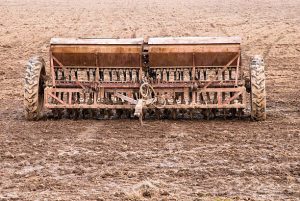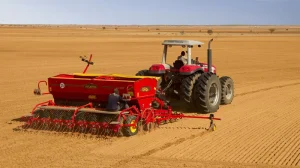Seed drills have revolutionized modern agriculture, offering precision and efficiency in seed sowing. In this comprehensive guide, we will explore various facets of seed drills, from their common uses to specialized types and components.
1. Uses of Seed Drill
Understanding the diverse applications of seed drills is crucial in modern agriculture. Let’s explore the various uses that make these machines indispensable for farmers.
Common Uses
- Precision Seeding: Seed drills allow for accurate seed placement, ensuring optimal spacing and reducing waste. The precision in seeding leads to uniform crop growth.
- Time Efficiency: Farmers save time by using seed drills, covering more ground compared to traditional manual seeding methods. This efficiency is especially valuable during peak planting seasons.
- Conservation Agriculture: Seed drills promote conservation practices by minimizing soil disturbance, preventing erosion, and preserving moisture. This contributes to sustainable farming practices.
2. What is Seed Drill Class 8
For Class 8 students studying agriculture, comprehending the concept of a seed drill is essential. Let’s break down the key aspects of seed drills tailored for a Class 8 audience.
Key Points
- Definition: A seed drill is a mechanized agricultural tool used for sowing seeds in a controlled manner. It replaces manual seed sowing with a more efficient and precise process.
- Components: Explore the main components of a seed drill, such as seed containers, tubes, and colters. Understanding these parts helps students grasp the mechanics of seed drills.
- Working Mechanism: Understand how seed drills operate, from seed placement to depth control. Class 8 students can appreciate the technology behind seed drills, enhancing their understanding of modern farming equipment.
3. What is a Modern Seed Drill?
The evolution of seed drills has brought about modern innovations, significantly impacting agricultural practices. Let’s delve into the features that define a modern seed drill.
Modern seed drills have come a long way from Jethro Tull’s ingenious invention in 1701, evolving into sophisticated machines that combine precision with efficiency. Here’s a glimpse into the world of modern seed drills:
Types of Modern Seed Drills:
- Pneumatic seed drills: These drills use compressed air to convey seeds from the hopper to the planting units, allowing for accurate placement even with delicate seeds or uneven terrain.
- Mechanical seed drills: These drills rely on mechanical mechanisms, such as rollers or brushes, to move seeds through the system. They are typically more affordable than pneumatic drills but may not be as precise, especially for small seeds.
- Precision planters: These high-tech drills utilize advanced technology, like GPS guidance and individual seed metering, to achieve unparalleled accuracy and efficiency. They are often used for high-value crops and large-scale farming operations.
Key Features of Modern Seed Drills:
- Multiple rows: Modern drills can plant seeds in multiple rows simultaneously, covering large areas quickly and efficiently.
- Variable rate seeding: This technology allows farmers to adjust the seeding rate based on soil conditions, crop type, and other factors, optimizing resource use and yield.
- Fertilizer application: Many drills can apply fertilizer simultaneously with planting, saving time and resources.
- Integrated monitoring systems: Advanced drills may have sensors that monitor planting depth, seed spacing, and other parameters, providing valuable data for optimizing operations.
Modern Features
- GPS Technology: Some modern seed drills incorporate GPS for precise seed placement and field mapping. This technology allows farmers to monitor and manage their fields with unprecedented accuracy.
- Variable Rate Technology: Adjust seeding rates based on field conditions and crop requirements for optimal efficiency. This feature ensures that seeds are sown at the right density across different areas of the field.
- Automated Depth Control: Advanced models come with automated depth control systems, ensuring consistent sowing depth. This automation enhances efficiency and reduces the need for constant manual adjustments.
Benefits of Modern Seed Drills:
- Increased yields: Precise seed placement and optimal spacing lead to better germination and growth, resulting in higher crop yields.
- Reduced labor: Modern drills are highly automated, significantly reducing the amount of time and labor required for planting.
- Improved resource efficiency: Accurate seeding and fertilizer application minimize waste and optimize resource use.
- Data-driven decision-making: Monitoring systems provide valuable data that farmers can use to make informed decisions about their operations.
The Future of Seed Drills:
The future of seed drills is likely to see further advancements in automation, precision, and data integration. We can expect to see drills that can adjust planting parameters based on real-time soil and weather conditions and even robotic systems that can handle the entire planting process autonomously.
So, the next time you see a field bursting with crops, remember that it might be the result of a modern seed drill, silently working behind the scenes to ensure efficient and productive agriculture.
Modern Features
- GPS Technology: Some modern seed drills incorporate GPS for precise seed placement and field mapping. This technology allows farmers to monitor and manage their fields with unprecedented accuracy.
- Variable Rate Technology: Adjust seeding rates based on field conditions and crop requirements for optimal efficiency. This feature ensures that seeds are sown at the right density across different areas of the field.
- Automated Depth Control: Advanced models come with automated depth control systems, ensuring consistent sowing depth. This automation enhances efficiency and reduces the need for constant manual adjustments.
4. Seed Drill Spare Parts
Maintaining seed drill efficiency involves understanding and replacing key spare parts. Explore the importance and common components of seed drill spare parts for seamless agricultural operations.
Importance of Spare Parts
- Performance Enhancement: Quality spare parts contribute to precise seed placement and overall seed drill performance. Seed drills equipped with well-maintained parts operate with enhanced accuracy.
- Durability: Regular replacement extends the lifespan of the seed drill, saving costs over time. Durable spare parts ensure the longevity of the equipment, minimizing downtime.
Common Spare Parts
- Seed Tubes: Facilitate seed flow, requiring regular inspection and prompt replacement. Clean and functional seed tubes ensure uninterrupted seeding operations.
- Discs or Coulter Blades: Cut through the soil for seed placement, requiring periodic sharpening or replacement. Sharp blades are essential for effective soil cutting and seed placement.
5. What is the Role of Seed Drill in Agriculture
The seed drill’s role in agriculture is pivotal, influencing efficiency and yield. Explore how this innovative tool contributes to the success of modern farming practices.
Key Contributions
- Precision Sowing: Seed drills ensure accurate seed placement, optimizing crop growth and reducing seed wastage. This precision results in a higher yield per acre.
- Conservation Agriculture: Minimizing soil disturbance, and seed drills contribute to conservation practices, promoting sustainable farming. Reduced soil disturbance also aids in retaining soil moisture.
6. What is Air Seed Drill
Air seed drills represent a technological advancement in agriculture. Let’s uncover the features and benefits that make air seed drills stand out in modern farming.
Features
- Pneumatic Seeding: Air seed drills use air pressure to distribute seeds evenly, improving seeding accuracy. This technology minimizes variations in seed spacing, leading to more uniform plant stands.
- Reduced Seed Damage: Gentle seed handling minimizes seed damage during the sowing process. This feature ensures that seeds remain intact and viable for optimal germination.
7. What is a Grass Seed Drill
Grass seed drills cater specifically to the needs of grass cultivation. Discover the features and applications that make grass seed drills essential in pastoral farming.
Applications
- Pasture Establishment: Grass seed drills facilitate efficient sowing for pasture establishment. Even the distribution of grass seeds contributes to the establishment of healthy and dense pastures.
- Improved Germination: Precise seed placement and depth control enhance grass germination rates. This is crucial for achieving a lush and uniform grass cover.
8. What is ATV Seed Drill and How It Works
The ATV seed drill is a versatile tool designed for efficiency in agriculture. Explore the features and workings of this innovative equipment tailored for all-terrain farming.
Features
- All-Terrain Capability: ATV seed drills are designed to navigate diverse landscapes, optimizing seed distribution in challenging conditions. This versatility allows farmers to plant seeds in areas that are hard to reach with traditional equipment.
- Compact Design: The compact structure of ATV seed drills allows for easy maneuverability and access to hard-to-reach areas. This feature is especially beneficial in smaller or irregularly shaped fields.
9. Which Seed Drill is Used in Wet Conditions
Choosing the right seed drill for wet conditions is crucial for successful farming. Let’s explore the characteristics and options available for effective seeding in wet environments.
Suitable Options
- No-Till Seed Drills: No-till drills are ideal for wet conditions, minimizing soil disturbance and preserving moisture. This feature helps prevent soil erosion and compaction in wet fields.
- Pneumatic Seed Drills: Air seed drills can handle wet conditions well, ensuring precise seed placement without causing soil compaction. The pneumatic seeding mechanism contributes to uniform seed distribution in wet soils.
10. What is No-Till Drill and How It Works
No-till drills have transformed modern agriculture by minimizing soil disturbance. Delve into the workings and benefits of no-till drills in sustainable farming practices.
Working Mechanism
- Seed Placement Without Disturbance: No-till drills plant seeds without plowing or tilling the soil, preserving its structure. This minimizes soil erosion and enhances soil health.
- Weed Suppression: Reduced soil disturbance helps control weeds, promoting a more sustainable and eco-friendly farming approach. This feature reduces the need for herbicides and supports organic farming practices.
11. What is Seed Drill Used for Wheat and How Deep It Goes
Understanding the specific requirements for wheat cultivation is vital for farmers. Explore how seed drills are tailored for optimal wheat seeding, including sowing depth considerations.
Wheat Seeding with Seed Drills
- Precision Seeding: Seed drills ensure even and precise placement of wheat seeds, optimizing crop yield. This precision is crucial for maximizing wheat production.
- Depth Adjustment: Farmers can customize seeding depth based on soil conditions and wheat variety requirements. This flexibility allows for optimal seed placement at the right depth for successful germination.





